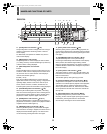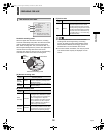
INSTALLATION AND CONNECTIONS3
14 English
INTRODUCTION
The SENSOR ALARM OUT terminals are used to relay
alarm signals whenever one of the digital video recorder’s
motion sensors is triggered. Normally in an open condition,
a terminal adopts low condition when a sensor for the
corresponding camera number has been triggered.
The connections for a remote control circuit are shown
below. This digital video recorder can be remotely controlled
when a remote-control circuit similar to that shown here is
connected to the remote-input control terminals.
z Use a resistance of 1/10 ohms or more and with a D
ranking (Precision within ±0.5%).
z The remote control cable should be no more than 5 m
long.
* The DSR-3709 can operate up to nine cameras (*).
1 When you have finished making all the
other connections, make sure the
voltage is 120 V-240 V AC and insert the
power plug into the wall outlet.
There is no power switch. The display indicators flash, and after
a few moments, the monitor screen displays the camera image.
z When turning the power on for the first time
“PLEASE SET THE CLOCK” is displayed on the monitor
screen. Follow the procedures on P.17 to set the clock.
z If the clock is already set
The operation display area is displayed.
z If the POWER indicator starts flashing;
If a problem occurs during use, the POWER indicator
will begin to flash and an explanation will be displayed.
In these cases, contact a Sanyo service center.
z The power cord’s ground terminal is not provided for
enhanced safety; rather, it can be used to reduce the
level of interference when the digital video recorder is
connected to analog devices.
If a large amount of noise is generated when the digital
video recorder is connected to analog devices, connect
this terminal to the building’s earth.
Connecting SENSOR ALARM OUT
terminals
Connecting CONTROL terminals
1
K
Rating for each terminal
z Maximum current: 25 mA
z Maximum voltage: 25 V
R1C R2
SW 1
SW 2
SW 3
SW 4
SW 5
SW 6
SW 7
SW 8
SW 9
SW 10
SW 11
SW 12
SW 13
SW 14
SW 15
SW 16
SW 17
SW 18
SW 19
SW 20
SW 21
SW 22
SW 23
SW 24
SW 25
SW 26
SW 27
SW 28
SW 29
SW 30
SW 31
SW 32
R1 R2
: Camera 1*: INDEX +
: Camera 2*: INDEX -
: Camera 3*:
AUTO FOCUS
: Camera 4*: SEQUENCE
: Camera 5*: MON2
: Camera 6*: PLUS
: Camera 7*: QUAD
: Camera 8*: MULTI
: Camera 9*:
MENU RESET
: Camera 10:
: Camera 11: PAN left
: Camera 12: PAN right
: Camera 13: TILT down
: Camera 14: TILT up
: Camera 15: ZOOM wide
: Camera 16: ZOOM tele
: REC/STOP
: PLAY/STOP
: STILL
: SEARCH
:
SHIFT (Doubles with R1)
: PLAY
: REC
: MENU
: EXIT/OSD
: +
: -
:
→
:
←
: ZOOM
: COPY
: TIMER
(When combined
with R2 Shift key)
(When operated
independently)
Connecting the power cord
POWER
indicator status
Meaning
Four flashes per
second
There is a problem with the hard disk. The
hard disk must be replaced or initialized.
Contact a Sanyo service center to recover
recorded images.
One flash per
second
There is a problem with the fan.
120 V-240 V AC
(50/60 Hz)
02
0
01-01-04 00:00:00 REC REPEAT EN A ALARM 0000
Operation
display area
e00_l8hbg_us_7.book Page 14 Thursday, November 25, 2004 1:44 PM


















